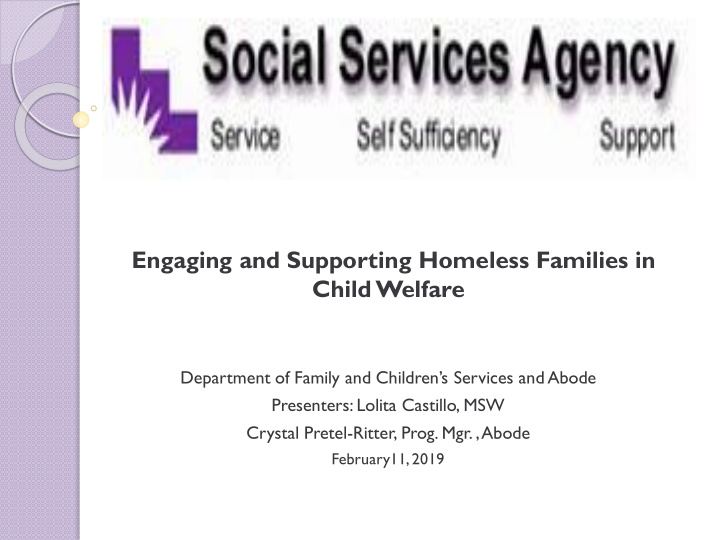



Engaging and Supporting Homeless Families in Child Welfare Department of Family and Children’s Services and Abode Presenters: Lolita Castillo, MSW Crystal Pretel-Ritter, Prog. Mgr. , Abode February11, 2019
AGENDA Introduction I. Brief Description of BFH II. Overview of Child Welfare III. I. Mission of Child Welfare II. How does a family get involved in Child Welfare? III. Characteristics / Risks factors present in families in child welfare IV. Link between poverty and maltreatment V. Rate of homelessness among families in Child Welfare VI. Resources available for families Best Practices with families in child welfare. Working towards IV. success Q and A V.
Introductions Presenters Purpose of Presentation
Bringing Families Home Goal Eligibility Criteria Services Program Status
Overview of Child Welfare
Child Welfare DFCS Mission Statement The mission of Santa Clara County Department of Family and Children’s Services is to keep children safe and families strong. With respect and cultural humility, we partner with our diverse community to ensure that any child or youth who is at risk or has suffered abuse or neglect is safe, cared for and grows up in a stable, loving family.
How does a family get involved in Child Welfare? It begins when someone reports a suspected child abuse or neglect. A report may be taken for information only and no action is taken, or a SW may be assigned to investigate. The outcome of the investigation can be one of the following: The referral is closed. The family is referred to a Community Partner (Differential Response) The family is offered Voluntary Services. The family is court ordered to participate in Family Maintenance or Family Reunification Services.
Characteristics Associated with increased odds of Child Welfare Events Deeper Poverty Substance abuse Mental health issues Domestic Violence Single parent family Lack of social support Homelessness Prior child welfare contact
Link between poverty and child mal-treatment “ Socio-Economic Status (SES) is 1 of the strongest and most consistent predictors of child maltreatment. 10 , 11 In the Fourth National Incidence Study, children in low SES households were 3 times more likely to be abused and ∼ 7 times as likely to be neglected as children in higher SES households. 9 Sources: Sedlak AJ, Mettenburg J, Basena M, Peta I, McPherson K, Greene A . Fourth National Incidence Study of Child Abuse and Neglect (NIS-4): Report to Congress . Washington, DC: US Department of Health and Human Services, Administration for Children and Families; 2010 National Research Council, Panel on Research on Child Abuse and Neglect . Understanding Child Abuse and Neglect .Washington, DC: National Academies Press; 1993
Homelessness among child welfare involved families Rate of homelessness High rate of child welfare system involvement among homeless Homelessness and substandard housing conditions could pose a risk to health and safety of children. Stress associated with being homeless or living doubled up could exacerbate disorders. Exposure bias/fishbowl effect
DFCS Resources Child Development Program- subsidized child care Mental Health DV Programs Parenting Classes Drug treatment Transportation Family Preservation Funds Bringing Families Home Season of Sharing
Best Practices: Engaging and Supporting Families in Child Welfare Practice defined: the values, principles, relationships, approaches and techniques used at the system and casework practitioner level to enable children and families to achieve the goals of safety, stability, permanency and well-being.
Best Practices A. Importance of collaboration, coordination B. Trauma Informed Care Exposure to traumatic stress is a common denominator for children, adults across social service systems. Traumatic events- experiences, whether real or perceived, that threatens ones life or bodily integrity and invokes intense feelings of helplessness, terror or powerlessness. Trauma Informed care is: Is a strengths- based service delivery approach. Grounded in an understanding of and responsiveness to the impact of trauma. Emphasizes physical, psychological safety, and emotional safety for survivors and providers. Creates opportunities for survivors to rebuild a sense of control and empowerment.
. Best Practices Going back to basics Maslow’s Hierarchy of Needs
Best Practices Trusting, helping relationship o Quality of relationship is essential to engagement; healing happens in relationships. Accessible and responsive services provided within their own neighborhoods and culture o Respecting diversity within the program, interventions specific to cultural background. Integrated Care o Having a holistic view of the person; Understanding the interrelatedness of various needs
Best Practices Family’s participation in decision making and planning courses of action o Fosters empowerment, autonomy, helps regain a sense of control over daily lives Strengths based o Recovery is possible; o Strengths affirmed and recognized – foundations for taking risks of change Plans that are needs-based, rather than service driven. The family’s informal helping system and natural allies essential to change. o Also, essential to sustainability.
References: Families at the Nexus of Housing and Child Welfare Trauma Informed Care and Trauma Informed Specific Services, American Institute for Research
THANK YOU
Recommend
More recommend